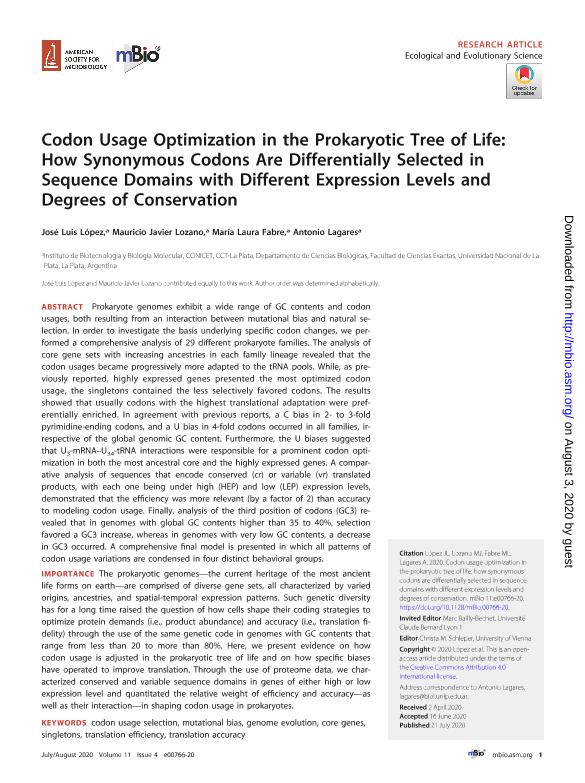Mostrar el registro sencillo del ítem
dc.contributor.author
López, José Luis

dc.contributor.author
Lozano, Mauricio Javier

dc.contributor.author
Fabre, Maria Laura

dc.contributor.author
Lagares, Antonio

dc.date.available
2022-03-31T19:47:21Z
dc.date.issued
2020-07-21
dc.identifier.citation
López, José Luis; Lozano, Mauricio Javier; Fabre, Maria Laura; Lagares, Antonio; Codon usage optimization in the prokaryotic tree of life: how synonymous codons are differentially selected in sequence domains with different expression levels and degrees of conservation; American Society for Microbiology; mBio; 11; 4; 21-7-2020; 1-20
dc.identifier.issn
2161-2129
dc.identifier.uri
http://hdl.handle.net/11336/154142
dc.description.abstract
Prokaryote genomes exhibit a wide range of GC contents and codon usages, both resulting from an interaction between mutational bias and natural selection. In order to investigate the basis underlying specific codon changes, we performed a comprehensive analysis of 29 different prokaryote families. The analysis of core gene sets with increasing ancestries in each family lineage revealed that the codon usages became progressively more adapted to the tRNA pools. While, as previously reported, highly expressed genes presented the most optimized codon usage, the singletons contained the less selectively favored codons. The results showed that usually codons with the highest translational adaptation were preferentially enriched. In agreement with previous reports, a C bias in 2- to 3-fold pyrimidine-ending codons, and a U bias in 4-fold codons occurred in all families, irrespective of the global genomic GC content. Furthermore, the U biases suggested that U3-mRNA–U34-tRNA interactions were responsible for a prominent codon optimization in both the most ancestral core and the highly expressed genes. A comparative analysis of sequences that encode conserved (cr) or variable (vr) translated products, with each one being under high (HEP) and low (LEP) expression levels, demonstrated that the efficiency was more relevant (by a factor of 2) than accuracy to modeling codon usage. Finally, analysis of the third position of codons (GC3) revealed that in genomes with global GC contents higher than 35 to 40%, selection favored a GC3 increase, whereas in genomes with very low GC contents, a decrease in GC3 occurred. A comprehensive final model is presented in which all patterns of codon usage variations are condensed in four distinct behavioral groups. IMPORTANCE The prokaryotic genomes—the current heritage of the most ancient life forms on earth—are comprised of diverse gene sets, all characterized by varied origins, ancestries, and spatial-temporal expression patterns. Such genetic diversity has for a long time raised the question of how cells shape their coding strategies to optimize protein demands (i.e., product abundance) and accuracy (i.e., translation fidelity) through the use of the same genetic code in genomes with GC contents that range from less than 20 to more than 80%. Here, we present evidence on how codon usage is adjusted in the prokaryotic tree of life and on how specific biases have operated to improve translation. Through the use of proteome data, we characterized conserved and variable sequence domains in genes of either high or low expression level and quantitated the relative weight of efficiency and accuracy—as well as their interaction—in shaping codon usage in prokaryotes.
dc.format
application/pdf
dc.language.iso
eng
dc.publisher
American Society for Microbiology

dc.rights
info:eu-repo/semantics/openAccess
dc.rights.uri
https://creativecommons.org/licenses/by/2.5/ar/
dc.subject
CODON USAGE SELECTION
dc.subject
MUTATIONAL BIAS
dc.subject
GENOME EVOLUTION
dc.subject
CORE GENES
dc.subject
SINGLETONS
dc.subject
TRANSLATION EFFICIENCY
dc.subject
TRANSLATION ACCURACY
dc.subject.classification
Biología Celular, Microbiología

dc.subject.classification
Ciencias Biológicas

dc.subject.classification
CIENCIAS NATURALES Y EXACTAS

dc.title
Codon usage optimization in the prokaryotic tree of life: how synonymous codons are differentially selected in sequence domains with different expression levels and degrees of conservation
dc.type
info:eu-repo/semantics/article
dc.type
info:ar-repo/semantics/artículo
dc.type
info:eu-repo/semantics/publishedVersion
dc.date.updated
2021-09-06T17:48:21Z
dc.identifier.eissn
2150-7511
dc.journal.volume
11
dc.journal.number
4
dc.journal.pagination
1-20
dc.journal.pais
Estados Unidos

dc.description.fil
Fil: López, José Luis. Consejo Nacional de Investigaciones Científicas y Técnicas. Centro Científico Tecnológico Conicet - La Plata. Instituto de Biotecnología y Biología Molecular. Universidad Nacional de La Plata. Facultad de Ciencias Exactas. Instituto de Biotecnología y Biología Molecular; Argentina
dc.description.fil
Fil: Lozano, Mauricio Javier. Consejo Nacional de Investigaciones Científicas y Técnicas. Centro Científico Tecnológico Conicet - La Plata. Instituto de Biotecnología y Biología Molecular. Universidad Nacional de La Plata. Facultad de Ciencias Exactas. Instituto de Biotecnología y Biología Molecular; Argentina
dc.description.fil
Fil: Fabre, Maria Laura. Consejo Nacional de Investigaciones Científicas y Técnicas. Centro Científico Tecnológico Conicet - La Plata. Instituto de Biotecnología y Biología Molecular. Universidad Nacional de La Plata. Facultad de Ciencias Exactas. Instituto de Biotecnología y Biología Molecular; Argentina
dc.description.fil
Fil: Lagares, Antonio. Consejo Nacional de Investigaciones Científicas y Técnicas. Centro Científico Tecnológico Conicet - La Plata. Instituto de Biotecnología y Biología Molecular. Universidad Nacional de La Plata. Facultad de Ciencias Exactas. Instituto de Biotecnología y Biología Molecular; Argentina
dc.journal.title
mBio
dc.relation.alternativeid
info:eu-repo/semantics/altIdentifier/url/https://mbio.asm.org/content/11/4/e00766-20
dc.relation.alternativeid
info:eu-repo/semantics/altIdentifier/doi/http://dx.doi.org/10.1128/mBio.00766-20
Archivos asociados
